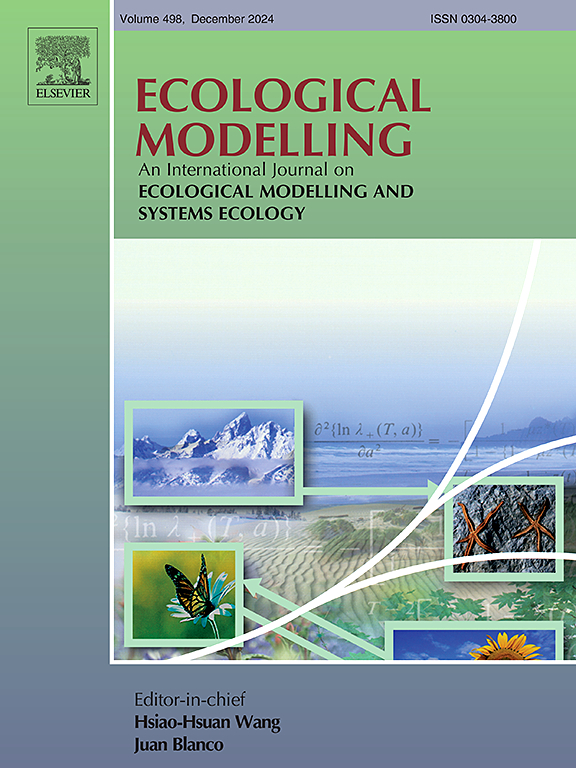微囊藻生长和毒素产生的机械种群水平(即微分方程)模型
IF 3.2
3区 环境科学与生态学
Q2 ECOLOGY
引用次数: 0
摘要
微囊藻蓝藻及其毒素微囊藻毒素(MC)的大量繁殖是一个重要的全球性环境问题。受这些蓝藻有害藻华(CyanoHABs)损害的水体的有效管理需要建模,但现有的操作规范通常不包括毒素。最近,我们提出了一个微囊藻生长和毒素产生的模型,该模型建立在大量文献荟萃分析的基础上,可以重现伊利湖(DOI: 10.1126/science.abm6791)和其他系统(DOI: 10.1016/j.hal.2024.102711)中观察到的产毒和非产毒基因型和MC浓度的序列。然而,该模型的复杂性和基于代理的建模(ABM)结构使其难以使用。在这里,我们提出了一个更简单、更通用的种群级模型(PLM),它可以集成到现有的操作性欧拉建模框架中。该模型包括产毒菌株和非产毒菌株,以及细胞内和细胞外MCs的状态变量。过程包括MC合成作为温度、光和氮可用性的函数,MC的益处(例如防止H2O2损伤),排泄和降解(细胞外)。提出了可变(即下垂)和固定(即Monod)浮游植物营养成分的两种版本。PLM还可以重现现场观测,管理方案的模拟与ABM一致,包括在部分n限制的系统中,在仅磷减少40%的策略下,MC浓度增加。该模型为缩小生物学理解和操作管理模型之间的差距迈出了实质性的一步。本文章由计算机程序翻译,如有差异,请以英文原文为准。

A mechanistic population-level (i.e. differential equation) model of Microcystis growth and toxin production
Blooms of the cyanobacteria Microcystis and its toxin microcystin (MC) are an important global environmental problem. Effective management of waterbodies impaired by these cyanobacteria harmful algal blooms (CyanoHABs) requires modeling, but existing operational codes generally do not include toxins. Recently, we presented a model of Microcystis growth and toxin production, which builds on a large literature meta-analysis and can reproduce the observed succession of toxigenic and non-toxigenic genotypes and MC concentration in Lake Erie (DOI: 10.1126/science.abm6791) and other systems (DOI: 10.1016/j.hal.2024.102711). However, that model's complexity and agent-based modeling (ABM) structure make it difficult to use. Here, we present a simpler and more general population-level model (PLM) that can be integrated into existing operational Eulerian modeling frameworks. The model includes toxigenic and non-toxigenic strains and state variables for intracellular and extracellular MCs. Processes include MC synthesis as a function of temperature, light and nitrogen availability, benefit of MC (e.g. protection against H2O2 damage), excretion and degradation (extracellular). Two versions for variable (i.e. Droop) and fixed (i.e. Monod) phytoplankton nutrient composition are presented. The PLM can also reproduce the field observations, and simulations of management options are consistent with the ABM, including an increase in MC concentration under a 40 % phosphorus only reduction strategy for systems with partial N-limitation. The model constitutes a substantial step towards closing the gap between biological understanding and operational management models.
求助全文
通过发布文献求助,成功后即可免费获取论文全文。
去求助
来源期刊

Ecological Modelling
环境科学-生态学
CiteScore
5.60
自引率
6.50%
发文量
259
审稿时长
69 days
期刊介绍:
The journal is concerned with the use of mathematical models and systems analysis for the description of ecological processes and for the sustainable management of resources. Human activity and well-being are dependent on and integrated with the functioning of ecosystems and the services they provide. We aim to understand these basic ecosystem functions using mathematical and conceptual modelling, systems analysis, thermodynamics, computer simulations, and ecological theory. This leads to a preference for process-based models embedded in theory with explicit causative agents as opposed to strictly statistical or correlative descriptions. These modelling methods can be applied to a wide spectrum of issues ranging from basic ecology to human ecology to socio-ecological systems. The journal welcomes research articles, short communications, review articles, letters to the editor, book reviews, and other communications. The journal also supports the activities of the [International Society of Ecological Modelling (ISEM)](http://www.isemna.org/).
 求助内容:
求助内容: 应助结果提醒方式:
应助结果提醒方式:


